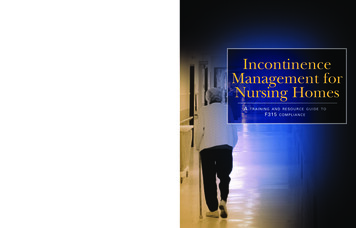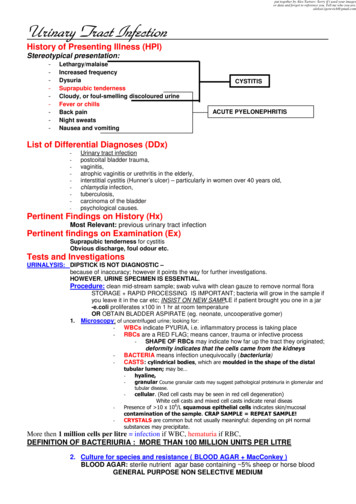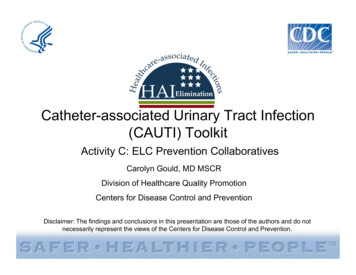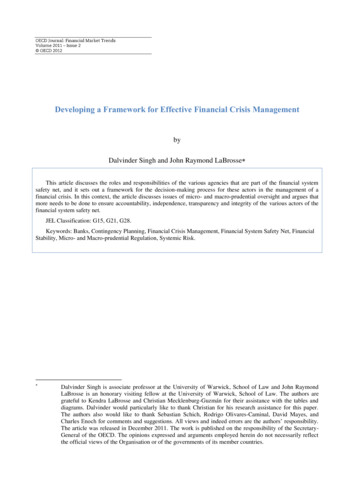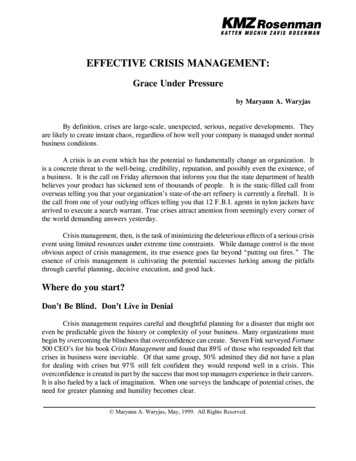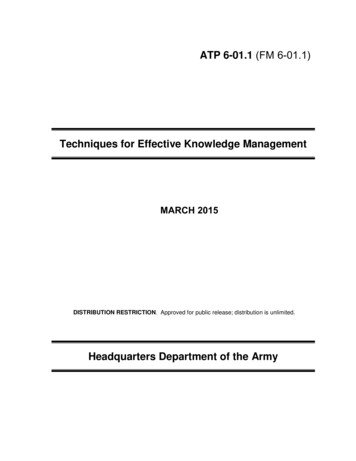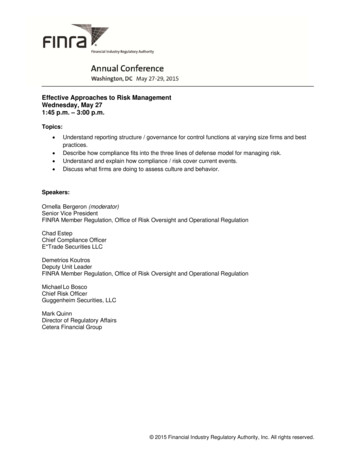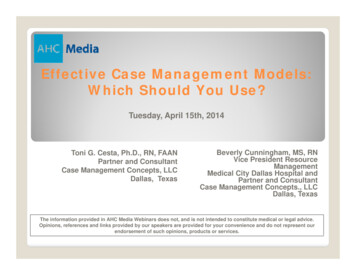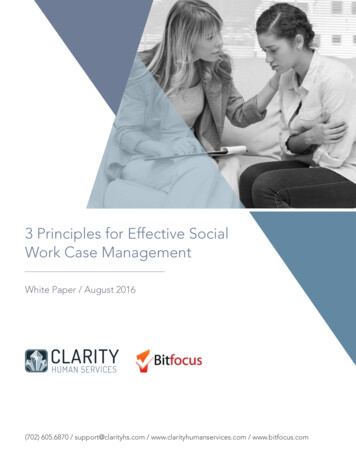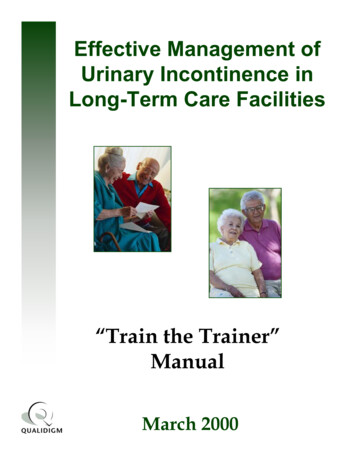
Transcription
Effective Management ofUrinary Incontinence inLong-Term Care Facilities“Train the Trainer”ManualMarch 2000
Effective Management of Urinary Incontinence in Long-Term Care FacilitiesTable of ContentsIntroduction.1Learning Objectives .2Licensed Staff .2CNA .3Presentations .4Licensed Staff .4CNA .5Assessment Form .6Medication List .7Algorithm.8AHCPR Guidelines.9Voiding Diary .10Post Test.11100 Roscommon DriveMiddletown, Connecticut 06457(860) 632-2008www.qualidigm.orgQualidigm
INTRODUCTION
Effective Management of Urinary Incontinence inLong-Term Care Facilities“Train the Trainer” ManualUrinary incontinence remains a major health problem in long term care. The challenges toeffectively manage this health problem can often appear daunting. The development of ourUrinary Incontinence Project grew from our desire to improve the quality of care related toresidents with urinary incontinence, thereby improving their quality of life.Upon completion of our baseline evaluation of your facilities, it was concluded that thecomprehensive assessment of urinary incontinence was not addressed completely. Thus, it wasdifficult to develop effective urinary incontinence diagnoses with subsequent effectivemanagement strategies without the appropriate assessment. The following "Train the Trainer"manual was collectively developed based on your suggestions and recommendations to furthereducate your staff on urinary incontinence assessment and effective management. You will notethe common theme of "assessment is key" throughout the manual, since it is the assessmentthat drives the plan of care.We hope, as you review and use the manual in your staff development activities related tourinary incontinence, that you will find it "user friendly" and an excellent resource forcontinuing education. Since this manual is intended as an additional intervention during thiscontinuous quality improvement project, we hope you find the tools useful in improving theawareness and knowledge required to deliver the best continence care possible.Sincerely,Courtney H. Lyder, ND, GNPClinical CoordinatorAnne Spenard, RN,C, MSNClinical ConsultantAnne Elwell, RNProject Manager
LEARNING OBJECTIVES
Effective Management of Urinary Incontinence in Long-Term Care FacilitiesLEARNING OBJECTIVESUpon completion of this training program, licensed staff will be able to:describe common reversible causes of urinary incontinencedifferentiate between chronic types of urinary incontinence and describeappropriate treatment options for each diagnosisdescribe evaluation procedures, which are appropriate for establishingdiagnosis of urinary incontinence in the long-term care settingdescribe the process for completing the Urinary Incontinence PhysicalAssessment and History Formdescribe all the components for completing the physical examination forurinary incontinenceQualidigmPage 2
Effective Management of Urinary Incontinence in Long-Term Care FacilitiesLEARNING OBJECTIVESUpon completion of this training program, CNAs will be able to:describe common types of urinary incontinencedescribe how to complete the 3 day voiding diarydescribe the techniques in bladder trainingfacilitate pelvic muscle (Kegel) exercisesidentify the steps to facilitating urinary incontinenceQualidigmPage 3
STEPS TO CONTINENCE1. Complete PhysicalAssessment and HistoryForm2. Determine the type ofUrinary Incontinence3. Complete Algorithm
PRESENTATION- Licensed Staff(for speaker’s notes please refer to the ppt file)
Overview of UrinaryIncontinence (UI) in theLong Term Care FacilityEvaluation and ManagementAnn M. Spenard RN, C, MSNCourtney Lyder ND, GNP
Learning Objectives Describecommon reversible causes of UI Differentiate between chronic types of UI anddescribe appropriate treatment options for eachdiagnosis Describe evaluation procedures, which areappropriate for establishing diagnosis of UI inthe long-term care setting Describe the process for completing the UIPhysical Assessment and History Form Describe all the components for completing thephysical examination for urinary incontinence
Steps to Continence1. Complete Physical Assessment andHistory form2. Determine the type of urinaryincontinence3. Complete Algorithm
Evaluation is the Key!Identification of the type ofurinary incontinence is thekey to effective treatment.
HistoryObtaining an accurate andcomprehensive UI History
Prevalence of Urinary Incontinence Estimated10% to 35% of adults 50% of 1.5 million nursing homeresidents A conservative estimated cost of 5.2billion per year for urinary incontinencein nursing homesFant et.al. Managing Acute and Chronic Urinary Incontinence. Rockville, MD Agency for Health Care Policy andResearch. 1996. AHCPR Publication No. 90-06 National Center for Health Statistics. Vital Health Statistics Series.13(No. 102). 1989e in
Impact on Quality of Life Lossof self-esteem Decreased ability to maintainindependent lifestyle Increased dependence on caregivers foractivities of daily life Avoidance of social activity andinteraction Restricted sexual activityGrimby et al. Age Aging. 1993; 22:82-89.Harris T. Aging in the Eighties: Prevalence and Impact of Urinary Problems in Individuals Age 65 and Over. WashingtonDC: Dept. of Health and Human Services, National Center for Health Statistics, No 121, 1988.Noelker L. Gerontologist. 1987; 27:194-200.
Consequences of UI Anincreased propensity for falls Most hip fractures in elders can be tracedto nocturia especially if combined withurgency Risk of hip fracture increases with)physical decline from reduced activity)cognitive impairments that may accompany a UTI)medications often used to treat incontinence) loss of sleep related to nocturia
Risk Factors Aging Medicationside effects High impact exercise Menopause Childbirth
Factors Contributing toUrinary Incontinence Medications tihypertensives)Hypnotics Bowel ecal Impaction)Sedatives
Age Related Changes in theGenitourinary Tract Majorityof urine production occurs atrest Bladder capacity is diminished Quantity of residual urine is increased Bladder contractions becomeuninhibited (detrusor instability) Desire to void is delayed
Types of Urinary Incontinence Stress Urge Mixed Overflow Total
Types of Urinary Incontinence Stress:Leakage of small amounts ofurine as a result of increased pressureon the abdominal muscles (coughing,laughing, sneezing, lifting) Urge: Strong desire to void but theinability to wait long enough to get to abathroom
Types of UrinaryIncontinence (continued) Mixed:A combination of two types,stress and urge Overflow: Occurs when the bladderoverfills and small amounts of urinespill out (bladder never emptiescompletely, so it is constantly filling) Total: Complete loss of bladder control
Remember.Urinary Incontinence canbe treated even if theresident has dementia!!
Cause of Stress UrinaryIncontinence Failureto store secondary to urethralsphincter incompetence
Causes of Urge UrinaryIncontinence Failureto store, secondary to bladderdysfunction)Involuntary bladder contractions)Decreased bladder compliance) Severe bladder hypersensitivity
Stress Incontinence vs. UrgeIncontinence: System Check ListSymptomsUrgency accompanies incontinence(strong, sudden desire to void)StressUrgeIncontinence IncontinenceNOYESLeaking during physical activity (e.g.coughing, sneezing, lifting, etc.)YESNOAbility to reach the toilet in time,following an urge to voidYESNOSELDOMOFTENWaking to pass urine at night
Causes of Mixed UrinaryIncontinence Combinationof bladder overactivityand stress incontinence One type of symptom (e.g., urge orstress incontinence) often predominates
Symptoms of OveractiveBladder Urgency Frequency Nocturia,and/or urge incontinence ANY COMBINATION - in the absenceof any local pathological or metabolicdisorder
Causes of Overflow UrinaryIncontinence Lossof urineassociated withover distention ofthe bladder Failure to empty)Underactive bladder Vitamin B12deficiency Outletobstruction)Enlarged Prostate)Urethral Stricture)Fecal Impaction NeurologicalConditions)Diabetic Neuropathy)Low Spinal Cord Injury)Radical Pelvic Surgery
Neurogenic BladderWhat is a neurogenic bladder? Amedical term for overflowincontinence, secondary to a neurologicproblem However, this is NOT a type of urinaryincontinence
Basic Types and UnderlyingCauses of IncontinenceTypeDefinitionStressLoss of urine with increase in intra- Weakness and laxity ofabdominal pressure (coughing,pelvic floor musculature,laughing, exercise, standing, etc.)bladder outlet or urethralsphincter weaknessLeakage of urine because ofDetrusor muscle instability,inability to delay voiding afterhypersensivity associatedsensation of bladder fullness iswith local genitourinaryperceivedconditions or centralnervous system disordersLeakage of urine resulting fromAnatomic obstruction bymechanical forces on an overprostate, stricture,distended bladder, or from othercystocele, acontractileeffects of urinary retention onbladder, detrusor-sphincterbladder and sphincter functiondyssynergyUrinary leakage associated withSevere dementia, otherinability to toilet because ofconditions that causeimpairment of cognitive and/orsevere immobility, andphysical functioning, unwillingness, psychological factorsor environmental barriersUrgeOverflowMixedCauses
Reversible or Transient ConditionsThat May Contribute to Restricted yuriaPharmaceuticals
*Dehydration Dehydrationdue to decreased fluidintake; increased output from diuretics,diabetes, or caffeinated beverages; orincreased fluid volume due to congestiveheart failure can concentrate the urine(increased specific gravity) and also leadto fecal impaction The specific gravity of the urine can betested to determine whether or not theresident is dehydrated
Basic Evaluation PhysicalExam Female genitalia abnormalities)Rectocele)Urethral Prolapse)Cystocele)Atrophic Vaginitis
Basic Evaluation forDifferential Diagnosis PatientHistory)Focus on medical, neurological, genitourinary)Review voiding patterns and medications)Voiding diary)Administer mental status exam, if appropriate PhysicalExam)General, abdominal and rectal exam)Pelvic exam in women, genital exam in men)Observe urine loss by having patient coughvigorously
Basic Evaluation for DifferentialDiagnosis (continued) Urinalysis)Detect hematuria, pyuria, bacterimia,glucosuria, proteinuria)Post void residual volume measurementby catheterization or pelvic ultrasound
Lab Results Labresults from approximately the last30 days:)Calcium level normal 8.6 - 10.4 mg/dl)Glucose level normal fasting 65 - 110 mg/dl)BUN normal 10 - 29 mg/100 ml (OR))Creatinine normal 0.5 - 1.3 mg/dl)B12 level (within the last 3 years) normal 200- 1100pg/ml*Normal lab values may vary depending on laboratory used.
Three Day Voiding Diary Threeday voiding diary should becompleted on the resident Assessment should be completed 24hours a day for 3 days Make sure CNA’s are charting when theresident is dry or not, the amount ofincontinence, if the voiding wasrequested or prompted
Basic Continence EvaluationFocused Physical Exam, including: Pelvicexam to assess pelvic floor & vaginalwall relaxation and anatomic abnormalitiesincluding digital palpation of vaginal sphincter Rectal exam to rule out fecal impaction &masses including digital palpation of analsphincter. Neurological exam focusing on cognition &innervation of sacral roots 2-4 (Perineal Sensation) Post Void Residual to rule out urinary retention Mental Status exam when indicated
Simple Urologic Tests ProvocativeStress Testing Key components)Bladder must be full)Obtain in standing or lithotomy position)Sudden leakage at cough, laughing,sneezing, lifting, or other maneuvers
Female Exam of Urethra andVaginaDuring a bed side exam the nurse shouldobserve for the following: The presence of pelvic prolapse(urethroceles, cystoceles, rectoceles))It is more important that you identify thepresence of a prolapse than the particulartype Isthe vaginal wall reddened and/
that drives the plan of care. We hope, as you review and use the manual in your staff development activities related to urinary incontinence, that you will find it "user friendly" and an excellent resource for continuing education. Since this manual is intended as an additional intervention during this continuous quality improvement project, we hope you find the tools useful in improving the .
